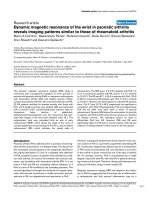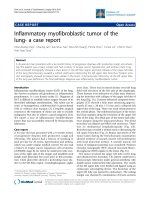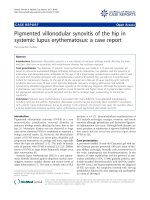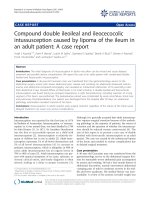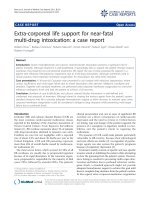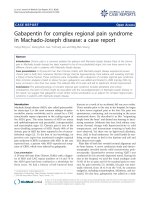Báo cáo y học: "Calcified amorphous tumor of the heart in an adult female: a case report" docx
Bạn đang xem bản rút gọn của tài liệu. Xem và tải ngay bản đầy đủ của tài liệu tại đây (604.04 KB, 3 trang )
CAS E REP O R T Open Access
Calcified amorphous tumor of the heart in an
adult female: a case report
Ruchika Gupta
1
, Milind Hote
2
, Ruma Ray
1*
Abstract
Introduction: Cardiac calcified amorphous tumor is a rare, non-neoplastic intra-cavity cardiac mass composed of
calcium deposits in a background of amorphous degenerating fibrinous material. Only a few cases of this rare
lesion have been reported in the available literature. Clinico-pathological differentiation of this lesion from calcified
atrial my xoma, calcified thrombi or other cardiac neoplasms is extremely difficult; hence pathologic examination is
the mainstay of diagnosis. To the best of our knowledge this entity has not been reported in the Indian literature.
Case presentation: A 40-year-old woman of Indian origin presented with progressive dyspnea, fatigue and cough.
She was diagnosed as having a calcified right atrial mass. The mass was excised. Histologic examination revealed
the mass to be composed of amorphous eosinophilic fibrin with dense calcification. No myxomatous tissue was
seen and a final diagnosis of calcified amorphous tumor of the heart was rendered.
Conclusions: Calcified amorphous tumor is a rare cardiac lesion with an excellent outcome following complete
surgical removal. Since clinico-radiologic differentiation from other cardiac masses is not possible in most cases,
histopathological examination is the only modality for diagnosis. Hence, histopathologists should be aware of this
rare entity in the differential diagnoses of cardiac mass.
Introduction
Cardiac myxomas a re the most common primary car-
diac tumors, occurring most frequently in left atrium
[1]. On the other hand, calcified amorphous tumor
(CAT) is a recently described non-neoplastic lesion with
a clinical presenta tion similar to other cardiac masses
[2]. Histopathologically, cardiac CAT shows calcified
nodules in an amorphous fibrinous b ackground with
degeneration and focal chronic inflammation [2]. Exci-
sion of the lesion and pathologic examination is manda-
tory for an accurate diagnosis and differentiation from
themorecommonatrialmyxomas.Veryfewcasesof
cardiac CAT have been reported in the available English
literature [2-7]. To the best o f our knowledge, no such
case has been reported from the Indian sub-continent.
Wedescribethecaseofarightatrialmass,which
proved to be a CAT on histopathology. The case is
being reported for its rarity and lack of reports in the
Indian literature.
Case presentation
A40-year-oldwomanofIndianoriginpresentedwith
history of gradual ly worsening breathlessness on exer-
tion, fatigue and non-productive cough for the past six
months. There was no significant past or family history.
General and systemic examinations were unremarkable.
Routine laboratory investigations were within normal
limits. Electrocardiogram and chest radiograph were
also unremarkable. Transthoracic echocardiography
showed a right atrial mass measuring 3 × 3 × 1.5 cm
with focal calcification. A clinical possibility of calcified
right atrial myxoma was considered. Our patient under-
went cardiac exploration and removal of the mass.
Intra-operatively, a calcified mass measuring 3 × 2 × 1.5
cm was noted in the right atrium with multiple sites
of attachment to the septum and right atrial wall. The
specimen was sent for histopathological examination.
We received a single piece of calc ified tissue measur-
ing 3 × 2 × 1.5 cm. The lesion was well-circumscribed
with focal congestion. The entire tissue was processed
for histopathology. Sections showed a lesion composed
of a background of eosinophilic amorphous material,
possibly degenerated fibrin, with areas of dense
* Correspondence:
1
Department of Pathology, All India Institute of Medical Sciences, Ansari
Nagar, New Delhi - 110029, India
Full list of author information is available at the end of the article
Gupta et al. Journal of Medical Case Reports 2010, 4:278
/>JOURNAL OF MEDICAL
CASE REPORTS
© 2010 Gupta et al; licensee BioMed Central Ltd. This is an Open Access article distributed under the terms of the Creative Commons
Attribution License ( which permits unrestricted use, distribut ion, and reproduction in
any medium, provided the original work is properly cited.
calcification and focal chronic inflammation (Figures 1
and 2). Multiple sections were examined and did not
reveal any cellular foci of ‘myxomatous’ tissue. Immuno-
histochemistry for calretinin was negative. Considering
the clinical and histological features, a diagnosis of car-
diac calcified amorphous tumor (cardiac CAT) was ren-
dered. Our patient has been doing well during eight
months of follow-up.
Discussion
Primary cardiac tumors are rare and the most common
of these are atrial myxomas [1]. However, not all cardiac
masses are neoplasms; for instance intra-mural thrombi
are great mimics of neoplasms [2,8]. Regardless of the
nat ure of a cardiac mass (neoplastic or not), excision of
the lesion is important due to the potential danger of
obstruction or embolization and also for accurate diag-
nosis a nd therapy. Cardiac CAT is a recently described
non-neoplastic intra-cardiac lesion composed of nodules
of calcium on a background of amorphous fibrinous
material [2]. The rarity of this lesion is borne out by the
fact that a 29-year review at the Mayo clinic yielded
only 11 such cases [2]. The clinical presentation of car-
diac CAT is similar to that of other cardiac masses, i.e.
dyspnea, syncope or symptoms related to embolism.
Hence, the most frequent clinical impression is a cardiac
myxoma, as in our patient. Ot her clinical differential
diagnoses include thrombi, emboli, vegetations and
other benign and malignant cardiac tumors [2,9].
Investigations such as echocardiography help in identi-
fying the location, echogenecity and morphology of car-
diac masses. In a study of 11 cases, cardiac CATs were
described as pedunculated, predominantly left ventricu-
lar, diffusely calcified masses on echocardiography [2].
Cardiac myxomas, on the other hand, are mobile left
atrial masses (may also invol ve the right atriu m). About
20% of the myxomas may be calcified [10]. Cardiac
fibromas may also be calcified; however, they are predo-
minantly left ventricular tumors with an intra-myocar-
diac location [11]. Other causes of calcification in the
heart i nclude chronic renal failure and, rarely, thrombi
[2]. In the absence of distinctive clinical and imaging
features, a pre-operative differentiation between neoplas-
tic a nd non-neoplastic lesions remains difficult. Hence,
histological diagnosis is the gold standard for a definitive
conclusion.
The various histological differential diagnoses for car-
diac CAT include myxoma, vegetations, Echinococcus
cysts and thrombi. A small fraction of myxomas may cal-
cify and even ossify; hence, adequate sampling is impera-
tive to exclude underlying myxomas [2]. In our case,
extensive sampling failed to reveal any myxomatous tis-
sue. Cardiac vegetations are intimately associated with
valve leaflets and may rarely calcify. Echinococcosis can
be diagnosed by the identification of the cyst wall and
presence of scolices [2]. Thrombi may undergo mummi-
fication and calcification and mimic cardiac CAT. The
absence of predisposing c onditions for thrombosis, lack
of characteristic laminations of an organizing thrombus
and infrequent presence of hemosiderin differentiates
CAT from an organizing thrombus [2].
The pathogenesis of cardiac CAT is not certain. How-
ever, most authors support the hypothesis that cardiac
CAT is an organized and calcified mural thrombus
[2-4]. This is supported by the presence of factors pre-
disposing to thrombosis in some patients described in a
large series [2]. However, the absence of such predispos-
ing conditions in other patients, such as the present
case, suggests that thrombo sis may not be the only
Figure 1 Photomicrogra ph showing amorphous eosinophilic
fibrinous material along with dense calcification (hematoxylin
and eosin (H&E) ×100).
Figure 2 Photomicrograph demonstrating hyalinized tissue
with focal chronic inflammation and a focus of calcification
(H&E ×200).
Gupta et al. Journal of Medical Case Reports 2010, 4:278
/>Page 2 of 3
pathogenetic mechanism for these intriguing cardiac
masses.
The majority of the cases reported so far had a benign
course after surgical excision of the intra-cardiac mass,
although some residual calcium may be seen [2]. One
case of a recurrent cardiac CAT in a young patient has
also been reported [3]. Another patient, a 60-year-old
woman, had a fatal outcome of a cardiac CAT involving
right ventricular wall and chordae tendinae of the tricus-
pid valve [5]. Hence, these patients need to be kept on
follow-up after surgical excision with repeat imaging
studies in cases with incomplete resection.
Conclusions
Cardiac CATs are rare intra-cardiac non-n eoplastic
masses with a presumed thrombotic origin. Since the
clinical presentation is similar to other cardiac tumors
such a s myxoma, surgical excision and histopathologic
examination remains the mainstay of an accurate
diagnosis.
Consent
Written informed consent was obtained from the patient
for publication of this case report and any accompany-
ing images. A copy of the written consent is availabl e
for review by the Editor-in-Chief of the journal.
Abbreviations
CAT: calcified amorphous tumor
Author details
1
Department of Pathology, All India Institute of Medical Sciences, Ansari
Nagar, New Delhi - 110029, India.
2
Department of Cardiothoracic and
Vascular Surgery, All India Institute of Medical Sciences, Ansari Nagar,
New Delhi - 110029, India.
Authors’ contributions
RG and RR were involved in the signing out of the histopathology report,
conducting the literature review and drafting the manuscript. MH was the
clinician-in-charge of the daily care of the patient, provided the clinical
background, assisted in the drafting and critical review of the manuscript. All
the authors have read and approved the final manuscript.
Competing interests
The authors declare that they have no competing interests.
Received: 5 November 2009 Accepted: 19 August 2010
Published: 19 August 2010
References
1. Markel ML, Waller BF, Armstrong WI: Cardiac myxoma. Medicine 1987,
66:114-125.
2. Reynolds C, Tazelaar HD, Edwards WD: Calcified amorphous tumor of the
heart (cardiac CAT). Hum Pathol 1997, 28:601-606.
3. Fealey ME, Edwards WD, Reynolds CA, Pellikka PA, Dearani JA: Recurrent
cardiac calcified amorphous tumor: the CAT had a kitten. Cardiovasc
Pathol 2007, 16:115-118.
4. Chaowalit N, Dearani JA, Edwards WD, Pellikka PA: Calcified right
ventricular mass and pulmonary embolism in a previously healthy
young woman. J Am Soc Echocardiogr 2005, 18:275-277.
5. Lewin M, Nazarian S, Marine JE, Yuh DD, Argani P, Halushka MK: Fatal
outcome of a calcified amorphous tumor of the heart (cardiac CAT).
Cardiovasc Pathol 2006, 15:299-302.
6. Tsuchihashi K, Nozawa A, Marusaki S, Moniwa N, Oh-numa Y, Kuno A,
Takagi S, Takizawa H, Ura N, Shimamoto K: Mobile intracardiac calcinosis:
a new risk of thromboembolism in patients with haemodialysed end
stage renal disease. Heart 1999, 82:638-640.
7. Morishima A, Sasahashi N, Ueyama K: Calcified amorphous tumors with
excision in hemodialysis patients: report of 2 cases. Kyobu Geka 2006,
59:851-854.
8. Sayin AG, Vural FS, Bozkurt AK, Oz B, Uygun N: Right atrial thrombus
mimicking myxoma and bilateral pulmonary artery aneurysms in a
patient with Behcet’s disease: a case report. Angiology 1993, 44:915-918.
9. Pietro DA, Parisi AF: Intracardiac masses: tumors, vegetations, thrombi
and foreign bodies. Med Clin North Am 1980, 64:239-251.
10. Burke AP, Virmani R: Cardiac myxoma: a clinicopathologic study. Am J Clin
Pathol 1993, 100:671-680.
11. Tazelaar HD, Locke TJ, McGregor CGA: Pathology of surgically excised
primary cardiac tumors. Mayo Clin Proc 1992, 67:957-965.
doi:10.1186/1752-1947-4-278
Cite this article as: Gupta et al.: Calcified amorphous tumor of the heart
in an adult female: a case report. Journal of Medical Case Reports 2010
4:278.
Submit your next manuscript to BioMed Central
and take full advantage of:
• Convenient online submission
• Thorough peer review
• No space constraints or color figure charges
• Immediate publication on acceptance
• Inclusion in PubMed, CAS, Scopus and Google Scholar
• Research which is freely available for redistribution
Submit your manuscript at
www.biomedcentral.com/submit
Gupta et al. Journal of Medical Case Reports 2010, 4:278
/>Page 3 of 3



